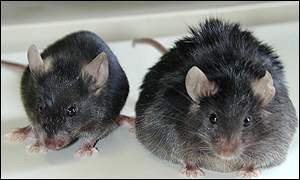 |
 |
 |
 Health & Beauty | May 2006 Health & Beauty | May 2006  
Studying the 'Sweet Tooth'
 Joy Victory - ABC News Joy Victory - ABC News


| | Japanese scientists believe they may have found an antidote for a sweet tooth. A hormone called leptin, released by fat cells in the body, has been found to suppress cravings for sweet and sugary food, at least in mice. |
Is junk food addictive?

That's not a simple question to answer, because addictions are highly variable. For example, when it comes to the king of addictions - nicotine - some people get hooked, while others can have a few cigarettes and never want more.

So the same is probably true of food that qualifies as junk food - high-calorie but low-nutrient foods like sodas, chips and candy bars. Not everyone craves these foods.

However, one main ingredient of junk food - sugar - seems to have unique addictive properties, researchers say, at least when it comes to rats.

After being fed a sugar-rich diet, rats showed signs of chemical dependency on sugar, said Bart Hoebel, a Princeton University psychology professor.

For several years now, he and others have been studying the addictive properties of sugar on the brain in rats.

But, it's not the sugar that's addictive, it's the high it causes. Like drugs, sugar stimulates the release of dopamine, a "feel-good" neurotransmitter - among other functions. However, eating protein or other foods doesn't cause as big a rush of happy chemicals. Sugar is somewhat unique.

The very simplified basics of his and others' research: For a one-month period, rats were fasted/starved for a long time each day, and then given a heavy dose of sugary fluids - sort of like drinking a large Coke for breakfast. They also were given normal food later in the day.

After the sugar meal, Hoebel's team measured that the rats experienced a flood of dopamine, and that their opioid - morphine/opium - receptors were activated.

Rats Hooked on Sugar?
After a few days, the rats were "hooked" - wanting to drink more each day. Their brains created more dopamine receptors. After a month of this schedule, when the sugar was removed, or the dopamine was chemically blocked using a drug, anxiety increased, to the point that the rats' teeth audibly chattered - a sign of withdrawal, Hoebel said.

When given sugar again after a few days, they ingested even more - showing the tendency to crave it, too.

"As weeks go by, the rats take in more and more and more [sugar]," Hoebel said. "Like a good addict might, the crucial next thing is step two: They learn to binge. By day 20, when they get it, they drink a lot all at once. That's our definition of a binge."

What was especially interesting was that rats got a dopamine high even if they didn't actually digest the sugar. One set of rats had drains placed in their stomachs that made all the fluid secrete out. Even in that group, the rats craved sugar.

However, Hoebel said it's too early to know how this might apply to humans. And, because sugar is a substance every mammal needs for a quick source of energy, it's hard to know whether this was something that was normal - that the body rewards us with pleasure for eating something it naturally needs.

"Shall we call this sugar addiction? This is milder than drug addiction, I'll admit that right up front," he said. "[But] why does sugar take on addictivelike properties? Because binging on sugar can repeatedly release dopamine." | 
 | |
 |



